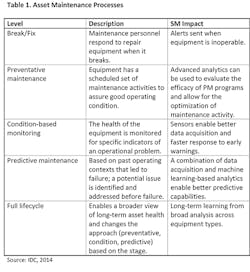In terms of hype noise levels in technology today, nothing may be more cacophonous than the Internet of Things (IoT). As you are probably already well aware, technology vendors want to connect everything in your personal and professional lives to make things run better. The investment signal in this technology hype noise is in the use cases. For manufacturing, this revolves around the concept of smart manufacturing (or Industry 4.0 if you are based in Europe).
The concepts aren’t entirely new to the industry (e.g., machine-to-machine), but certainly recent technology advances allow us to bring together data capture, connectivity, remote control and, most importantly, analytics to deliver on the promise of cyber-physical manufacturing sooner than you might think. Certainly, our inquiry activity with research clients has been robust on this topic.
As a result of these ongoing industry conversations about smart manufacturing, we recently published a PlanScape report on the subject. This methodology frames the why, what, how and who of an investment initiative. The objective is to give our research clients a jump start on creating an investment plan. In this article, we look at the why of investing in smart manufacturing.
Executives accept the inevitability of a cyber-physical manufacturing future and understand intuitively the competitive value of having responsive operational capabilities, but building the business case from the ground up can be tricky. In order to assist clients in the process, IDC Manufacturing Insights encourages companies to begin with the construct of overall equipment effectiveness (OEE). Those familiar with the metric know it includes considerations for efficiency, utilization and yield.
Efficiency: Beating the Plan
Efficiency is a measure of throughput usually expressed as actual versus expected (or standard). So if the expected throughput of a machine is 10 units per hour and it produces 11, it is considered 110% efficient. Efficiency is obviously important because if a machine can produce more, there are more products to sell without adding new capacity. However, for the purpose of investing in smart manufacturing, efficiency should be thought of in several dimensions beyond just the machine efficiency:
- Labor efficiency—factory personnel are able to manage more machines.
- Material efficiency—optimizing set ups and production sequences so less material is sacrificed to scrap.
- Energy efficiency—optimizing the consumption of energy in the process which may include running the equipment slower.
Collectively, there are opportunities to improve efficiencies across all of these dimensions through the application of smart manufacturing principles.
Utilization: Improving Availability
An efficient machine is useless if it is broken. Manufacturers have often calculated productivity as efficiency multiplied by utilization. Utilization is simply a measure of the cumulative time of operation divided by the total elapsed time. So if our example machine is available 99% of the time, then the productivity is 108.9% (110% multiplied by 99%).
Availability comes down to keeping the equipment running. Asset intelligence—understanding the operating condition, predicting failure, interdicting to minimize disruption—is the common categorization and is integrated to a company's enterprise asset management (EAM) system. There are varying levels of asset management (as shown in Table 1).
Asset management can extend beyond just the operating equipment to include tools, tooling, jigs, fixtures and inspection equipment—all of which need to be available and well maintained. This domain is also a common starting point for many companies to test how to deploy and use smart manufacturing-related technologies as it is less invasive to the production process and can produce quick paybacks.
Quality: Real Time Measurement
The last component of effectiveness is reliability. There has been a lot of progress in transitioning measurement tools and equipment—calipers for mechanical, environmental test chambers for electronics, etc.—to provide digital recording. And the information is getting more complex with visual inspection systems sending calibrated image files for example. Smart manufacturing initiatives will incorporate and integrate those digital readings and other outputs into a more disciplined root cause analysis and corrective action capability.
Improving reliability isn’t just about integrating the data from inspection equipment. One of the capabilities manufacturing companies describe is an ability to support design for experiments (DFE). The concept is that if plant management believes they may have a problem, they can turn on specific pieces of data acquisition and test the results against upper and lower limits, better identifying a set of conditions that may be causing a quality problem. DFE has always been part of the Six Sigma methodologies, but has been a very manual proposition to execute. Smart manufacturing approaches will assist in automating this critical quality function.
Of course, DFE can also extend beyond just testing for quality parameters. Experiments related to asset operation would be available, but perhaps the most interesting could be A/B testing to improve throughput (efficiency). As an example, consider a plant that has two production lines that are equipped in a similar fashion. Operations management wants to decide the best way to calibrate and operate those lines to produce product X. One line uses a set of parameters (e.g., line speed, staffing, material quality)—call that test A—and the other uses a different set (test B), by comparing the results for equipment, material, labor and energy efficiency; the company can choose the best set up.
Quantifying the Benefits
Before writing the business case, OEE improvements must be tied to well understood financial metrics, including all the major elements of corporate return on assets: revenue, costs and asset levels.
Increased Revenue
By increasing the OEE of the company’s factory network, a firm can enjoy higher revenue levels. However, it may not be as simple as more output means more revenue and several dimensions must be considered:
At capacity—If the company is currently selling everything it produces and could sell more if it could produce more, the consideration is quite simple—increased production means increased revenue.
Customer satisfaction—Having smart manufacturing capabilities enables an enterprise to be more responsive to customer needs. Delivering a quality product on time builds customer loyalty so improved capabilities can be critical to gaining a larger share of existing customers’ budgets and in stealing away customers from the competition.
Capital expenditure avoidance—A bit more of a bigger-picture proposition but if the company has plans to significantly increase revenues, improving throughput can mean that new capacity requirements can be optimized, saving precious cash.
Product variety—With customers increasingly asking for personalized or even customized products, having smart manufacturing capabilities may be critical to being able to meet those requirements and grow revenue.
It should be apparent that revenue based justification can be highly situational. Using revenue (or more accurately, the gross margin on that revenue) to justify investment will require building models that capture the necessary set of underpinning assumptions and will stand up to the inevitable scrutiny from management.
Cost Reductions
The more straightforward set of benefits for justification lie in the potential for lowering overall costs. There is a wide range of possibilities, but we offer several to consider:
Material costs—By increasing material efficiencies, raw material scrap can be reduced. This will vary widely by type of manufacturing and circumstances.
Energy efficiencies—Understanding the impact of production decisions on energy consumption can drive lower costs. IDC Manufacturing Insights expects savings in the range of 10% to 30%.
Labor costs—Smart manufacturing will enable employees to control a higher number of machines. A good rule of thumb would be the elimination of one employee for every eight pieces of equipment instrumented.
Maintenance costs—Applying more predictive analysis as well as better evaluating maintenance personnel should lower maintenance costs from between 5% and 65%. There is a wide range based on both the complexity of the equipment and the current maturity levels of the company. For example, if most of the maintenance is done on a break/fix or preventative basis, there is opportunity for large savings.
Cost of adverse quality—The costs of poor quality are well documented with a good rule of thumb being that every 1% increase in reliability translates to a 1.5% improvement in margins over the long term.
Each justification will be specific to company circumstances, so not every element needs to be included. However, in many cases there will be more than enough potential benefit to justify investment.
Bob Parker is group vice president, research, with IDC Manufacturing Insights, an analyst firm that assists manufacturing businesses and IT leaders, as well as the suppliers who serve them in making more effective technology decisions by providing fact-based research and consulting services.

